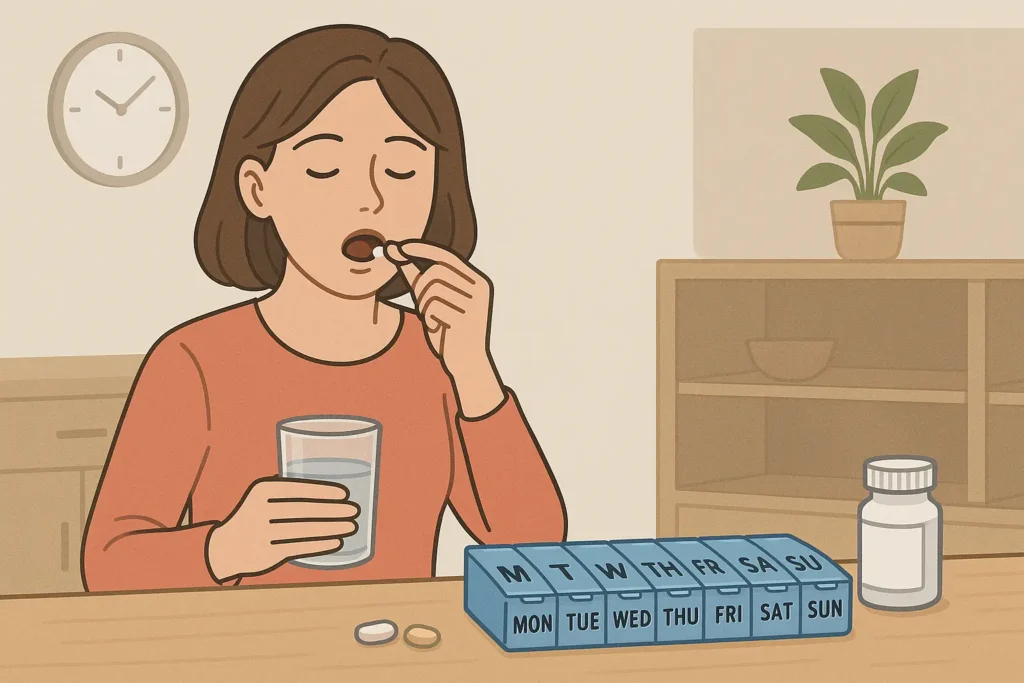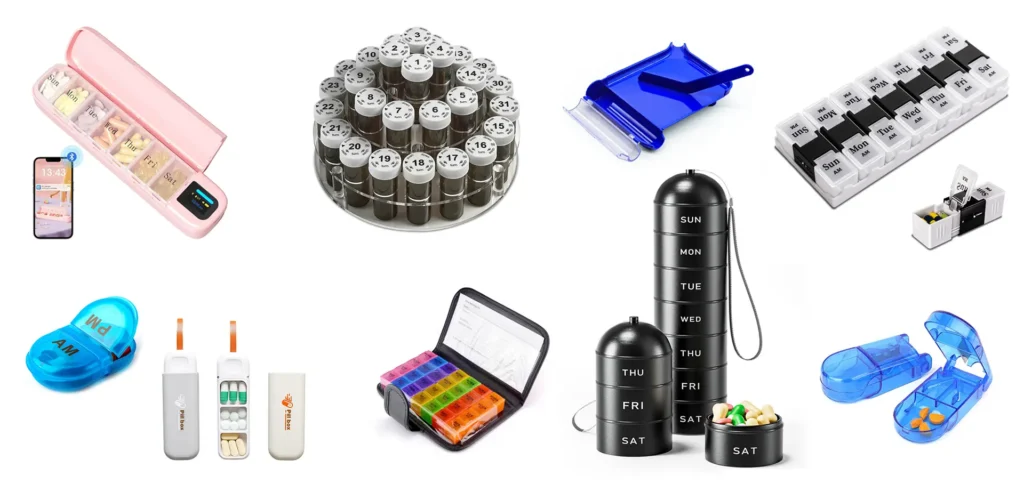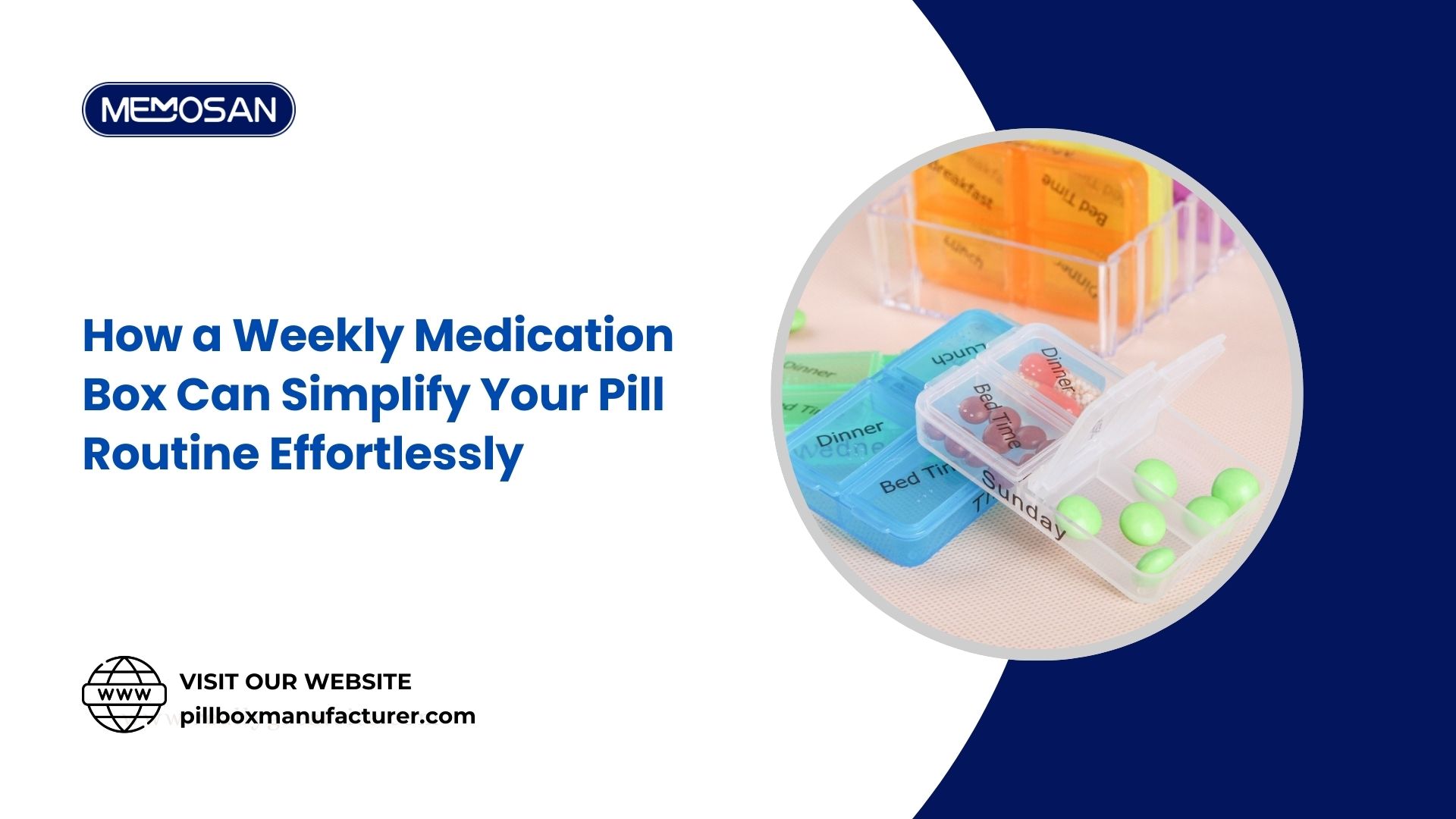
Research shows that over 125 million Americans take prescription medication every day. However, poor medication adherence costs the healthcare system $100 billion annually—much of which could be prevented by using the right pill organiser. Whether you are managing multiple medications or helping elderly family members, mastering pill organiser settings not only makes your daily pill management more convenient, but also makes your pill use safer.
This comprehensive guide to using pill boxes makes it easier to manage your daily medication. From choosing the right weekly pill box to establishing a foolproof daily medication schedule, this article describes how to use pill boxes to safely manage your medication. It helps you avoid safety incidents such as missing doses, repeated dosing, and forgetting to take your medication.
Many studies have shown that the correct use of pill boxes can reduce medication errors by 50% to 70% and significantly improve treatment outcomes. By mastering this basic knowledge, medication management can be transformed from a stressful burden into a simple daily routine.
References:
A comprehensive meta-analysis of 52 studies (22,858 adults) evaluating packaging interventions, including pillboxes and blister packs.
Result: Intervention groups showed an average adherence rate of 71%, compared to 63% in control groups — an approximate 13% relative improvement.
Effect size: Standardized mean difference (SMD) ≈ 0.593, considered moderate.
Focused on behavioral interventions using pillboxes.
Result: Pillboxes produced a moderate effect size (Cohen’s d ≈ 0.59), indicating a significant adherence improvement, commonly ranging from 50% to 70% depending on context.
Elderly cardiovascular patients using a 7-day, 4-times/day pillbox showed:
Improved medication adherence by 53% to 68% compared to baseline.
Using a smart pillbox with alarm reminders significantly improved adherence and clinical outcomes.
Result: Marked improvement in medication timing, quality of life, and symptom control.
Various types of medicine boxes

A pill organiser is a personal medication management tool that separates doses by time and date. Understanding the different types of pill organisers can help you choose the one that best suits your needs.
Basic Weekly Pill Organiser
This pill organiser has seven compartments labelled Monday to Sunday. It is ideal for people who take the same medication at the same time every day. The compartments are typically large enough to hold 2-6 capsules or tablets.
AM/PM Double Row 7-Day Pill Organiser
This pill organiser has fourteen compartments—one for each morning and evening dose. This weekly pill organiser is designed for people who take medication twice a day or who want to separate their morning vitamins from their evening prescriptions. The AM/PM design makes it easier to manage your pills.
Monthly Pill Box
This pill box offers 28-31 compartments for long-term medication planning. These larger medication organisers are more suitable for people with stable long-term prescriptions who want to refill less often.

Professional medicine boxes
Meet special needs: portable travel cases, lockable boxes for controlled medications, and large-capacity versions for oversized pills or multiple medications. Some products feature removable daily compartments for convenient use at work or while travelling.
Electronic pill box
This pillbox combines Internet technology with traditional pillboxes. Some have built-in alarms and light reminders, while others even support Bluetooth connectivity, providing dosage reminders via a smartphone app. The disadvantage of this pillbox is that it is more expensive, but it is very helpful for people with poor memory.
Choose your pillbox: Consider the complexity of your medication schedule, your manual dexterity, your vision, and your lifestyle needs. Recommendation: For most users, a simpler pillbox is often more convenient than a complex one.
Getting started: Prepare your medicine box
Proper use determines whether your medicine box will be a useful tool or a dangerous hazard. The preparation stage requires patience—carelessness can lead to safety risks.
Select the medicine box filling area:
Choose a clean, well-lit area away from distractions. A dining room table is a good place because it is well-lit and flat and clean. Avoid bathrooms and windows, as humidity and direct sunlight may affect the potency of the medication. Make sure there is enough space to lay out all the bottles or tablets.
Verify materials:
-The medicine box you have chosen (cleaned and checked)
-All prescription medicine bottles you need to use
-A list of medicines provided by your doctor
-A magnifying glass for reading small print if you have poor eyesight
-Clean paper towels
-Adequate lighting
-A calculator
Medication verification process:
Compare each prescription bottle with the medication list provided by the doctor. Check the expiration date—expired medications are ineffective and may even be harmful. Replace expired medications immediately.
Medication schedule:
Follow your doctor’s instructions. Some tablets need to be taken before meals, while others need to be taken after meals. However, once you have set a schedule, you need to stick to it strictly. Consistency in medication timing will help your body recover more quickly.
Pre-plan your pill box:
Before filling the pill box, plan out the medication according to when it should be taken. Put the morning medication together, the afternoon medication together, and the evening medication together. This pre-planning can prevent confusion during the actual filling process.
Safety precautions when filling medicine boxes:
Wash your hands thoroughly before handling medicines. Ensure that pets and children are kept away from the work area. Prepare the prescription issued by the doctor.
Medicine box tracking control settings:
Prepare a simple tracking method—a notebook or mobile phone memo—to record the medicines you add to each compartment each time. This backup system allows you to immediately identify where the problem lies when you make a mistake.
Instructions for gradually filling the medicine box
Systematic filling of pill boxes prevents errors and establishes a pill box filling plan. Please strictly follow the previously established medication sequence—changes in medication introduce unnecessary confusion and increase the probability of errors.
Step 1: Cleaning and inspecting the medicine box (3-5 minutes)
Thoroughly clean your pillbox with mild soap and water, then dry it completely. It is best to wipe it down with alcohol. Carefully check each compartment of the pillbox for cracks, residue, or foreign objects. Any damage must be replaced immediately—a damaged pillbox cannot properly protect your medications.
Step 2: Single drug treatment
If you are taking different types of pills, please select one type of medication to fill first. Do not mix different pills in the same compartment of the pill box. Different pills can cross-contaminate each other, posing a safety hazard. The best approach is to use a separate pill box for each type of medication, with one pill box containing only one type of pill.
For weekly pill boxes, you need to fill the seven compartments with the same dose of medication. Count twice each time you take your medication—once when you take it out of the bottle and once after you put it in the compartment. This double counting can help you spot any mistakes in the quantity.
Careful dosing: Never estimate or ‘eyeball’ the dose. Count each tablet every time.
Step 3: Systematic loading of the medicine box
Fill your pill box gradually, filling it in order, starting with morning medication, followed by afternoon medication, and finally evening medication.
This block processing method makes it easier to detect and correct tablet doses and quantities. If you find an error, it will be easier to know which medications and time periods to check.
Step 4: Verify
After filling each type of medication, calculate the number of tablets remaining in the original bottle.
Sample calculation:
There are 30 pills at the start.
After filling, 23 pills remain.
Difference: 7 pills were used.
Filled compartments: 7 days
If the numbers do not match, empty all compartments of the pill box and start over.
Step 5: Visual quality check
Check each compartment of the pill box for obvious errors: incorrect pill shapes, different colours, different quantities, etc. Checking the pill box visually is convenient and makes it easy to spot errors.
Step 6: Document recording and storage
Record the date of filling the medicine box, the medicines it contains, and any observations in a simple log or mobile phone memo. This document helps track medication patterns and provides useful information to doctors during visits.
Time commitment: Filling a weekly pill box takes approximately 5-10 minutes, while filling a complex multi-drug pill box takes 15-20 minutes. Do not skip the check to save time; your health is the most important thing.
Medicine box for daily use
Good habits can turn your pillbox into an excellent reminder tool to protect your health. Establishing the habit of using a pillbox requires patience, attention to detail, and consistent perseverance.
Time consistency: Take your morning medication at the same time every day, preferably within 30 minutes before or after the set time. If you do not have an electronic pill box, you can set an alarm manually or use your mobile phone’s memo function to remind yourself.
The correct way to take medicine from a pill box: Only open the compartment for the current day. Pour the pills into the palm of your hand instead of taking them directly from the pill box compartment—this allows you to check the number of pills before swallowing. Close the pill box immediately after taking the medicine.
Food and liquid considerations: Some medications need to be taken with food, while others are best taken on an empty stomach. Please follow your doctor’s instructions carefully. Be sure to use enough water each time you take your medication—usually 6-8 ounces per dose.
Evening and multiple dose administration
For weekly pill boxes with morning/afternoon compartments, do not combine morning and evening medications in the same compartment.
What to do if you miss a dose: If you realise you have missed a dose, do not double the next dose. Contact your doctor for specific instructions. Some medications need to be taken immediately, while others can be skipped.
Travel and Interruption Management
For short trips, if your pillbox is detachable, remove the compartment for that day. For long trips, consider taking the entire pillbox with you. Some pillboxes have key rings so you can hang them on your backpack or suitcase. Do not transfer pills to unlabelled containers, as this can cause confusion.
Regular interruption recovery: When travel or other things disrupt your normal routine, try to stick to your original schedule as much as possible.
Monitoring and adjustment
Weekly review process: Each time you refill the pill dispenser, check to see if any compartments have not been completely emptied. Remaining pills indicate that doses may have been missed.
Record daily usage information in your notebook or smartphone. This information can help doctors better understand your condition and develop a more effective treatment plan.
Safe medication use and error prevention
Medication safety requires care, patience, and error prevention strategies. Even minor errors can lead to serious health consequences.
Do not share your pillbox: Everyone needs their own pillbox, even relatives who take the same medication. The same medication may have different dosages, quantities, and times, and using the same pillbox poses a safety risk.
Storage location: Keep your medicine organiser away from heat, moisture, and direct sunlight. Although it may seem convenient to store it in the bathroom, moisture can accelerate the deterioration of medicines. A well-ventilated, shaded area such as the living room, dining room, or bedroom dressing table is more suitable for storing tablets.
Child safety precautions: Most medicine boxes are easy to open, so store them out of the reach of children. If you have children at home, consider using a lockable medicine cabinet or storing the medicine in a place that is out of reach of children.
Error identification and response
Identification errors: Common errors include incorrect medication types and incorrect medication quantities.
Immediate response protocol: When you discover that the medicine box has been filled incorrectly, you need to immediately count the medicines, remove all the medicines from the box, and refill it to prevent the error from recurring.
Recording requirements: Record the cause of the error in a memo so that you can better remind yourself.
Backup medicine supply: Store a 3-7 day emergency supply of essential medicines separately from your weekly pill box. This will prevent a shortage of medicines in the event of a natural disaster, pharmacy closure, or travel.
Resolve Common Issues
In real life, unexpected situations may arise when using medicine boxes, but appropriate preparation can quickly resolve these issues.
Cramped cubicles
Problem: Multiple large tablets or multiple medications may not fit into the compartments of the pill organiser. Forcing tablets into crowded spaces may damage the medication or make it difficult to retrieve.
Solution: Use a larger medicine box, or consider dividing the medicine into two boxes.
Confusion caused by mixed-up medicine boxes
Problem: Multiple family members use similar weekly pill boxes, which can lead to confusion, especially when the medications are similar.
Solution:
– Each person uses a different coloured pill organiser.
– Each pill organiser is labelled with the owner’s name.
– Different storage locations are designated within the household.
Damaged or faulty pill box organiser
Problem: Damaged switches, cracked compartments, or loose lids can compromise medication safety.
Solution: When refilling medications, carefully check the pill organiser. Try to purchase pill organisers with quality assurance, such as https://pillboxmanufacturer.com/. This is a factory that specialises in manufacturing pill organisers, with quality assurance, supplying many top Amazon merchants.
The safe use of medication organisers can greatly reduce medication errors.
This guide provides some tips on the safe use of medication organisers. If you notice any other points to note when using medication organisers, please feel free to contact us.



